
|
They are owned by the province and access to them during nesting season is by permit only.
My work on these islands is done in cooperation with Canadian Wildlife Service and the Nova Scotia Department of Natural Resources.

|
My work on these islands is done in cooperation with Canadian Wildlife Service and the Nova Scotia Department of Natural Resources.
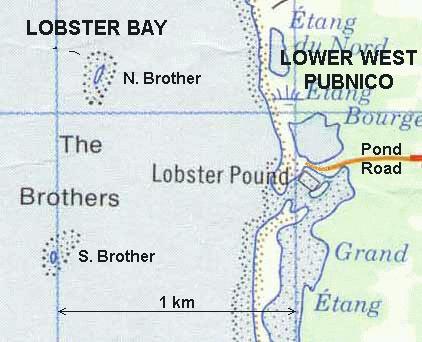 |
| THE BROTHERS, Yarmouth County, Nova Scotia |
The following is a synopsis of the tern status in southwest Nova Scotia for the 2005 nesting season. My "tern" work and observations deal primarily with the tern colony on The Brothers. These two tiny islands are located about 1 km offshore from Lower West Pubnico in Yarmouth County.
 The Roseate Terns did well on The Brothers in 2005. 68 Roseate Tern nests were identified. This compares to 76 nests in 2004 and 86 in 2003. This is after two successive years of Mink predation on the islands. During the 2003 and 2004 seasons, there was no Roseate Tern fledgeling success and even the loss of some adult Roseate Terns. The only type of tern predation on The Brothers in 2005 appears to be avian (likely owl) and this involved only a few Common and Arctic Terns. The Roseates were spared. There was also very little Roseate Tern chick mortality, however, too many Roseate Tern eggs failed to hatch; I don't know the reason why. 19 Roseate Tern chicks were banded on July 13 by Canadian Wildlife Service. A hybrid Roseate Tern chick was first seen when 2 or 3 days of age and again at about 10 days old. It could not be located again for banding on July 13 (see photos below).
The Roseate Terns did well on The Brothers in 2005. 68 Roseate Tern nests were identified. This compares to 76 nests in 2004 and 86 in 2003. This is after two successive years of Mink predation on the islands. During the 2003 and 2004 seasons, there was no Roseate Tern fledgeling success and even the loss of some adult Roseate Terns. The only type of tern predation on The Brothers in 2005 appears to be avian (likely owl) and this involved only a few Common and Arctic Terns. The Roseates were spared. There was also very little Roseate Tern chick mortality, however, too many Roseate Tern eggs failed to hatch; I don't know the reason why. 19 Roseate Tern chicks were banded on July 13 by Canadian Wildlife Service. A hybrid Roseate Tern chick was first seen when 2 or 3 days of age and again at about 10 days old. It could not be located again for banding on July 13 (see photos below).
 Paul Tufts, a retired Department of Natural Resources biologist and expert trapper, visited N. Brother three times in 2005. 1) On April 23, for an overview of the island and to plan the Mink trapping strategy. 2) On May 3, to place two wire fences where Mink traps could be set in the event Mink arrive on the island during tern nesting season. The fences were placed in a zig-zag fashion so as to make funnel-like points where traps would be placed if required, at a later date. It was expected a Mink on the island would try to get through the fence at these locations. 3) On June 27, three Mink traps were set under the overhanging bank at the south end of N. Brother. No traps were set into the fences, and no Mink visited the island during the 2005 nesting season. The mink traps did cause some fatalities, however. Three Common Tern chicks and one Common Crow were found dead in the traps. Also, one Common Tern chick was found dead, stuck into the mink fence.
Paul Tufts, a retired Department of Natural Resources biologist and expert trapper, visited N. Brother three times in 2005. 1) On April 23, for an overview of the island and to plan the Mink trapping strategy. 2) On May 3, to place two wire fences where Mink traps could be set in the event Mink arrive on the island during tern nesting season. The fences were placed in a zig-zag fashion so as to make funnel-like points where traps would be placed if required, at a later date. It was expected a Mink on the island would try to get through the fence at these locations. 3) On June 27, three Mink traps were set under the overhanging bank at the south end of N. Brother. No traps were set into the fences, and no Mink visited the island during the 2005 nesting season. The mink traps did cause some fatalities, however. Three Common Tern chicks and one Common Crow were found dead in the traps. Also, one Common Tern chick was found dead, stuck into the mink fence.
 18 new 16 inch x 16 inch Roseate Tern nest boxes were placed on N. Brother.
18 new 16 inch x 16 inch Roseate Tern nest boxes were placed on N. Brother.
 The first terns arrived in Lobster Bay on May 4, 2005.
The first terns arrived in Lobster Bay on May 4, 2005.
 One cripple Herring Gull was removed from N. Brother on May 29. One Great Black-backed gull nest containing one egg was destroyed on South Brother.
One cripple Herring Gull was removed from N. Brother on May 29. One Great Black-backed gull nest containing one egg was destroyed on South Brother.
 A total number of 445 tern nests on The Brothers, showed another decrease in 2005. This compares with 526 in 2004, and 750 in 2003. This is not surprising, after the two years of no success. No terns nested on S. Brother in 2004 or in 2005.
A total number of 445 tern nests on The Brothers, showed another decrease in 2005. This compares with 526 in 2004, and 750 in 2003. This is not surprising, after the two years of no success. No terns nested on S. Brother in 2004 or in 2005.
 Other tern colonies of the area:
Other tern colonies of the area:
Green Rock (also shown as "Green Island" on the charts) again had a small amount of Arctic Tern Nests (perhaps 10 pairs).
Little Half Bald Tusket Island (a.k.a. Inner Bald and Mossy Bald) appeared to have had a small tern colony in 2003 and in 2004, however, I had not landed on the island to actually check these out. I visited the small island on May 31, 2005. Even though there were a few terns above the island as we arrived, there did not appear to be any to be nesting there.
Île-aux-maringouins (a.k.a. Pinch Gut Island) and on Île-aux-fraises (a.k.a. Green Island): June 20, 2005 - very disappointing on both islands. Only 105 tern nests on Île-aux-maringouins. Most of the eggs were cold, some had been depredated. The only tern species seen there were Common Terns.
The situation on Île-aux-fraises was a little better even though the nest numbers were lower at only 59. Most of the tern eggs here were warm. Most of the terns were Common with one or two pairs of Arctics. It is possible there could have been a Roseate Tern nest on Île-aux-fraises. The single cold egg had been laid under a plywood structure. The egg fit the overlapping similarities of some Common Tern and of some Roseate Tern eggs. There were no Roseate Terns seen at Île-aux-fraises. In 2004, I had counted 459 Common and Arctic Tern nests on Île-aux-fraises; this was up from the 362 nests in 2003. I must note that there was a Great Black-backed Gull nest with two large chicks in the middle of the tern colony. The terns were very busy with the half a dozen or so GBb Gulls overhead. I feared few tern chicks will survive to fledge after the eggs hatch. I was not able to revisit this island.
There were still small colonies of Arctic Terns on Mud Island and on Flat Islands. I did not make a nest count on these two islands.
 Other species of interest:
Other species of interest:
Also at Green Rock, on May 31, we saw about 6 Puffins as well as 7 Razorbills coming out of a rocky islet. I am sure there were more Puffins there but the 7 Razorbills were a treat. The most Razorbills I had ever seen before at Green Rock were 3. This could almost be called a Razorbill colony. I expect they would be nesting there with the Puffins.
The Puffin colonies at Noddy Island and at Round Island (in the Mud Island group of islands) were still as active as usual.
 The following is a chronological listing of my 2005 work with terns in general, of the Lobster Bay area, but especially with the Roseate Terns of The Brothers. The report also includes tern observations from other local residents.
The following is a chronological listing of my 2005 work with terns in general, of the Lobster Bay area, but especially with the Roseate Terns of The Brothers. The report also includes tern observations from other local residents.
 |
| North Brother - 2005 |
April 19, 2005 - First visit to The Brothers in 2005. Landed on North Brother with 9 new 16 inch x 16 inch Roseate Tern nest boxes to be placed on the island. The observation platform was dismantled. I feared it has been and might still be used by predator owls as a lookout perch. The platform itself, to be used as a Roseate Tern nesting shelter.
Over the winter, a good portion of this island has been washed away; something this tiny island could ill afford.
 |
| the South end of North Brother - Extensive loss of soil on the south and west sides |
I will have to do some air reconnaissance over the island this summer and compare the photos with some taken a few years ago. I fear we may have lost about half the vegetated high land of the island to last winter's erosion. This is where the predominant nester was the Common Tern. Common Tern nests may be down this year; time will tell.
We did some cleanup of the nesting area, removing dead vegetation from last year and replacing rotted nesting boxes.
My helpers: Israel d'Entremont, Rémi d'Entremont, and Alain Comeau.
April 23, 2005 - I took Paul Tufts, a retired provincial biologist and trapper, to N. Brother to plan a strategy for the capture of Mink if and when one comes to the island. We were accompanied by Rémi d'Entremont.
April 26, 2005 - Another visit to N. Brothers accompanied by Israel and Rémi d'Entremont. We did some more cleanup and repairs of nest shelters. I realized I needed to fabricate a few more nest shelters.
May 1, 2005 - Wendell d'Entremont, (Israel's son) reported seeing a large wild Mink on the mainland of Lower West Pubnico, just adjacent to The Brothers.
May 3, 2005 - Major work on N. Brother. Israel, Rémi and I assisted Paul Tufts with the placement of two wire fences where Mink traps could be set in the event Mink arrive on the island during tern nesting season. The fences were placed in a zig-zag fashion so as to make funnel-like points where traps would be placed later. It is expected a Mink on the island would try to get through the fence at these locations.
 |
| Israel and Rémi assisting Paul with the setting up of the fence |
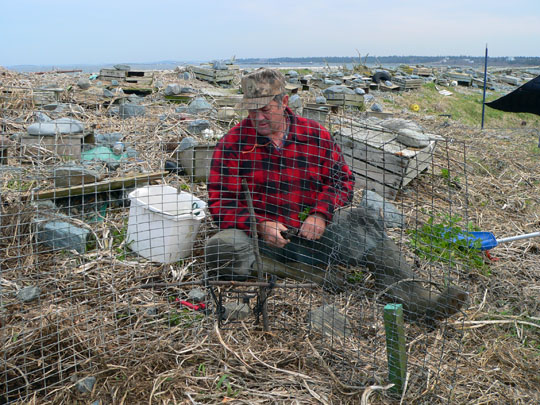 |
| Paul Tufts |
 |
| Mink trap |
I also brought and placed 9 more 16 inch x 16 inch Roseate Tern nesting shelters. Israel helped me with their fabrication.
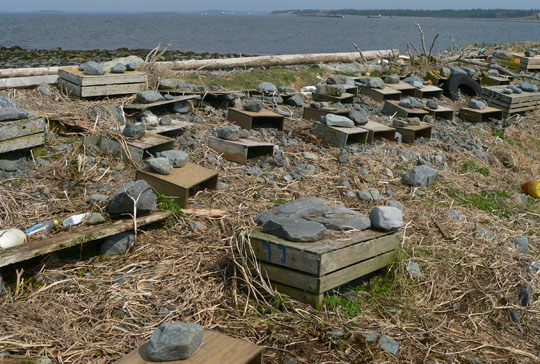 |
| Roseate Tern nest shelters on North Brother, NS |
May 4, 2005 - Lobster fishermen, Steve Swim and Robert Nickerson, reported 30 to 40 terns above The Brothers. Some terns were also reported feeding in the ponds at Lower West Pubnico.
May 17, 2005 - Checked out The Brothers for tern and gull activity with Israel, Rémi and Andrew D'Eon. We found about 70 terns above N. Brothers; a mix of Commons and Arctics with one pair of Roseate Terns. There were no bird nests of any kind on either of The Brothers with no tern activity on S. Brother. As we left N. Brother, a lone Raven settled on the island and was mobbed by the terns. We did not see it leave the island.
Lobster fisherman, Réal d'Entremont told me that earlier in the morning there were "about 1000 terns above N. Brother". We were there at 9 am.
We continued to the "Mud Islands". At Round Island we counted about 20 Puffins and the usual 100 or so, Black Guillemots. This is a high number of Puffins for this island. There were also about 30 Arctic Terns at Round I. also. Our next stop was Flat I., where there were another 50 or so Arctic Terns, plus 150 Brant and 2 pairs of American Widgeons. On Flat I. we found about 20 Common Eider nests and about 6 Great Black-backed Gull nests. The terns had not nested yet.
Our next stop was the south-west cove, (which I call "Puffin Cove"), on Noddy I. to count the Puffins. We found about 30 Puffins plus about 200 more Brant. We stayed aboard the boat at Noddy I. It was a great boat trip!
May 29, 2005 - Checked out The Brothers. On N. Brother, we counted about 120 Common and Arctic Tern nests. No Roseate Tern nest yet. Some Roseates above us. We were finding depredated tern nests; empty egg shells or partially emptied tern eggs - perhaps 7 or 8. We soon found the culprit - a cripple Herring Gull. It was captured and later released back on the mainland.
On S. Brother, I destroyed one Great Black-backed gull nest containing one egg. No terns were nesting on S. Brother.
Crew: Michel d'Entremont with Margie Rogers, and my adult children, Nigel and Ingrid.
 |
| Cripple Herring Gull on N. Brother, May 29, 2005 |
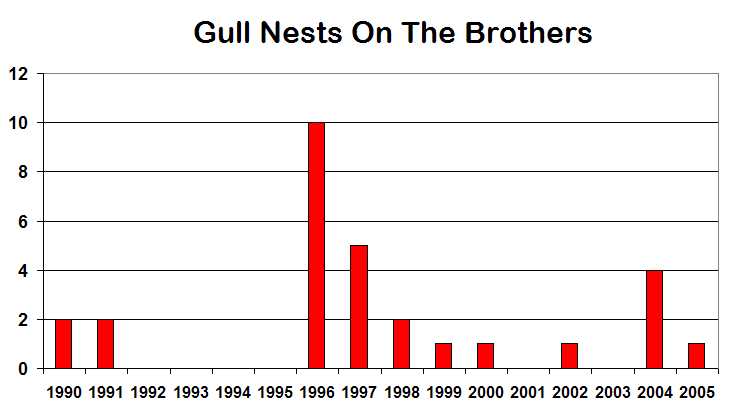 |
| Gull Nests Removed from The Brothers |
May 31, 2005 - Time to check out more distant islands for terns. Crew: Israel, Rémi, and Jean-Bernard d'Entremont, Nigel and Margie Rogers.
We first went to île-aux-maringouins (Pinch Gut I.) at the mouth of the Tusket River and a couple of km to the east of Wedgeport. There, we estimated a hundred or so, mostly Common Terns with some Arctics. We all remained in the boat. A few years ago this was a thriving tern colony with over 300 nests; then, a couple of years ago none nested here and I did not check the island in 2004. It now looks to be back into production. I will do a nest count in a couple of weeks.
Our second stop was île-aux-fraises (Green I.), a couple of km to the south of Wedgeport. Last year, a tern colony of 350 nests was abandonned by mid-season. There were about 300 Common and Arctic Terns here. We remained aboard the boat.
Third stop - Little Half Bald Tusket I. This is another small island; it is the next island to the south of Peases Island. We all went ashore. There were dozens of Common Eider nests. About half or more of them had been depredated, with Eider egg shells strewn here and there. The Great Black-backed Gulls which were also nesting there, being the likely predator. Even though there were a few terns above the island as we arrived there, there did not appear to be any nesting.
 |
| A view of my Royalsea-23 from the Little Half Bald Tusket Island looking towards Peases Island |
We continued to Holmes I. About 15 years ago there was a colony here of over 300 Common and Arctic Terns. Gradually the Commons disappeared from the island until only a couple of dozen pairs of Arctics remained. Then these disappeared also. Anyway, we could see a few terns on the grassy bank of this island. We may have a small tern colony again on Holmes I. We did not land but continued to Green Rock (Green I.). We did not land on Green Rock either. From the boat. I estimated about 10 pairs of Arctic Terns on one of the turf-covered rock outcrops on the east side of the island.
Still at Green Rock, we saw about 6 Puffins an well as 7 Razorbills coming out of a rocky islet. I am sure there were more Puffins there but the 7 Razorbills were a treat. The most Razorbills I had ever seen before at Green Rock was 3. This could almost be called a Razorbill colony. I expect they would be nesting there with the Puffins.
On our way back to Abbott's Harbour we stopped on the Big Tusket I. for a short visit. The weather was cold and overcast but we had a good day at sea. Our boat trip covered an estimated 80 km (50 miles). We even saw a Gannet and a few Harbour Porpoises.
June 4, 2005 - I went alone to the North Brother to do some observation of the tern colony. The colony is still in excellent shape. I did find some tern mortality, though. It looked like owl predation with decapitation and a mess of feathers on three of the victims. One dead Common tern and one Arctic were intact except that both of their wings were broken. The almost intact Common Tern was on the vegetated part of the island where Common Tern nesting is the most concentrated; the Arctic Tern, with the other dead terns, were found in the depression on the island where my observation platform used to be. One of the victims appeared to be a Common or an Arctic tern in "portlandica" plumage. The body was not with its detached head (see photo below). I guess I possibly could have left the platform there. I had removed it thinking the owl? might be using it as a perch to pounce upon unsuspecting terns during the night. It looks like the owl has its own ways of hunting terns.
 |
| Three of the five dead terns had been dismembered |
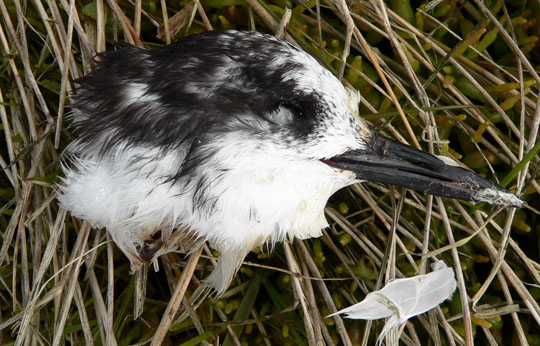 |
| Common or an Arctic tern in "portlandica" plumage |
 |
| Arctic Tern - intact, except that both wings were broken |
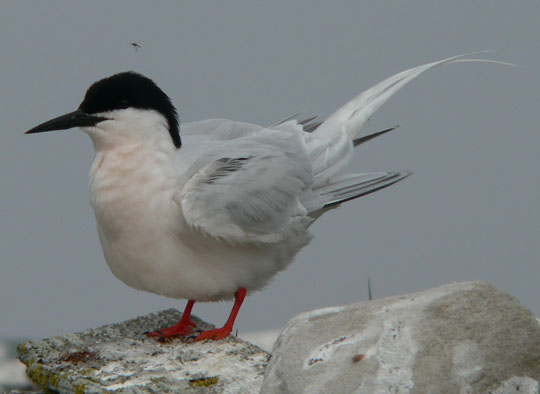 |
| Roseate Tern - Note the pinkish wash - June 4, 2005 (Ted D'Eon photo) |
On a brighter note, tern activity was high with Roseate Terns incubating under nest shelters, pairs interacting, even the mating of a pair of Common Terns. Two or three Roseates and one or two Common Terns had leg bands which I could not read. A quick check for Roseate Tern nests found 22 containing 1 egg and 2 nests with 2 eggs for a total of 24 Roseate Tern nests so far with many more to come.
 |
| Note the Roseate Terns nesting inside the shelters - June 4, 2005 (Ted D'Eon photo) |
I used the CWS collapsible blind for most of the observation. The terns quickly became used to it and were soon incubating the closest eggs. There were not very many Arctic Terns.
June 9, 2005 - N. Brother still in great shape. Two more adult Common Terns found dead. One was likely dead on June 5 - possibly an owl kill. The second could have died of disease, with diarrhea present (see photo).

|
| Dead Common Tern - N. Brother, June 9, 2005 |
A Common Eider nest with 3 eggs was found under the top of the dismantled observation platform. No gull nests or other gull problems were found. I was very pleased with the colony.
We continued about 24 km south west of Abbott's Harbour to Mud Island. Upon passing by Round I. we saw only 4 Puffins there, with the 100 or so Black Guillemots. We went for a walk around ponds of Mud I. and saw a pair of nesting Blue-winged Teals and lots of Common Eiders. I was expecting to see American Widgeons and a pair or two of Canada Geese there also. We had a very pleasant trip.
Crew: Israel d'Entremont, Rémi d'Entremont and Margie Rogers.
June 13, 2005 - Official census day on North Brother. We counted 445 tern nests; all three spicies, but mostly Common Terns. Of these, 45 were Roseate Tern nests. There were no new dead terns. No tern eggs had hatched yet. A second Common Eider nest containing 3 eggs, was also found.
|  |
Crew: Israel d'Entremont, Rémi d'Entremont and Margie Rogers.
June 18, 2005 - Visited The Brothers with my son, Nigel. Roseate Tern nest number on North Brother now up tp 54. Two of the previous RT nests were now empty. No new tern kills. Tern eggs were starting to hatch. Five newly-hatched chicks - 1 Arctic and 4 Common; no Roseates hatched yet. Two possibly-depredated tern eggs found - one with empty shell; the other appeared to have been pecked open, with partially-incubated chick still inside (see photo).
 |
| "with partially-incubated chick still inside" |
No nests of any kind on South Brother.
June 20, 2005 - Census day on Île-aux-maringouins (a.k.a. Pinch Gut Island) and on Île-aux-fraises (a.k.a. Green Island). Very disappointing on both islands. Only 105 tern nests on Île-aux-maringouins. Most of the eggs were cold, some had been depredated. The only tern species seen there were Common Terns.
The situation on Île-aux-fraises was a little better even though the nest numbers were lower at only 59. Most of the tern eggs here were warm. Most of the terns were Common with one or two pairs of Arctics. It is possible there may have been a Roseate Tern nest on Île-aux-fraises. The single cold egg had been laid under a plywood structure. The egg fit the overlaping similarities of some Common Tern and of some Roseate Tern eggs. There were no Roseate Terns seen at Île-aux-fraises.
 |
 |
| Roseate Tern Egg? in Nest Shelter | The single egg was cold |
There was a Great Black-backed Gull nest with two large chicks in the middle of the tern colony. The terns were very busy with the half a dozen or so GBb Gulls overhead. I fear few tern chicks will survive to fledge after the eggs hatch.
No tern eggs on either island had hatched by June 20.
Crew: Nigel, Alix d'Entremont and Andrea Atkinson.
June 23, 2005 - Another visit to N. Brother. All is still well on North Brother! We now have 56 Roseate Tern nests and 10 RT chicks plus 1 RT egg in the process of hatching and another 30 to 40 Common and Arctic Tern chicks. The only mortality found were two 1 to 3 day old Common Tern chicks. No signs of Mink.
Crew: Israel d'Entremont, Rémi d'Entremont, Nigel D'Eon and Pat Hudson.
June 27, 2005 - Time to set a few Mink traps. Retired biologist, Paul Tufts, set three Mink traps under the overhanging bank at the south end of N. Brother. So far, no Mink activity on the island. Only a few very young dead terns. One of these was a recently-dead Roseate and it was collected for Canadian Wildlife Service and placed in deep freeze.
Roseate Tern nest number now up to 65! 25 RT chicks were counted. About 15 of them were 4 days old or younger. The colony looked great. One of the RT chicks may be a hybrid - legs and feet like a Roseate with the body more like that of a Common tern.
 |
 |
| Hybrid Roseate Tern? | N. Brother - June 27, 2005 |
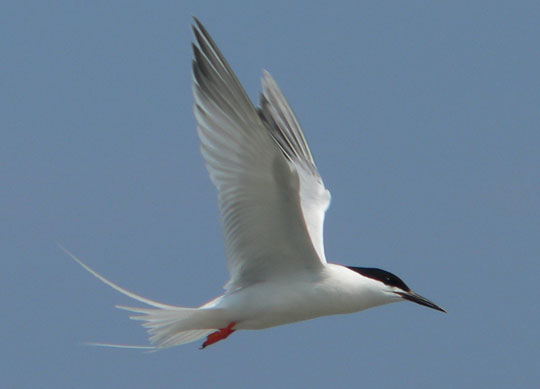 |
| Roseate Tern - N. Brother, June 27, 2005 (Ted D'Eon photo) |
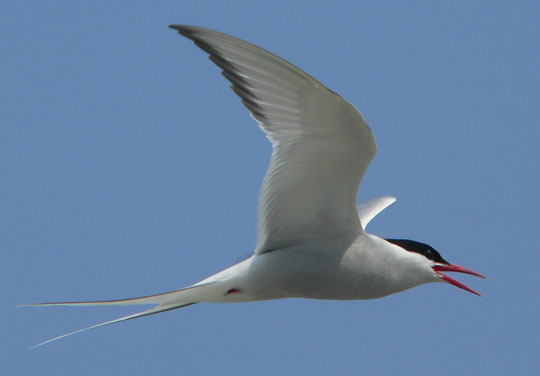 |
| Arctic Tern - N. Brother, June 27, 2005 (Ted D'Eon photo) |
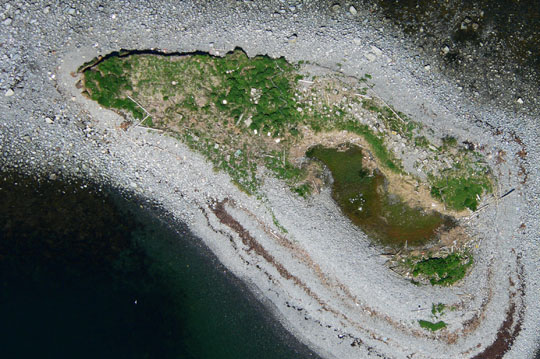 |
| Aerial photo of North Brother (Ted D'Eon photo from 2450 ft) |
 |
| Aerial photo of Roseate Tern nesting area - N. Brother (Ted D'Eon photo from 2450 ft) |
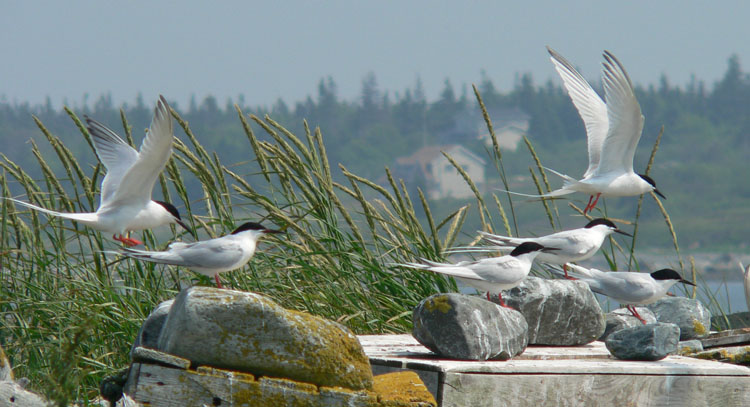 |
| Roseate Terns - N. Brother, June 27, 2005 (Ted D'Eon photo) |
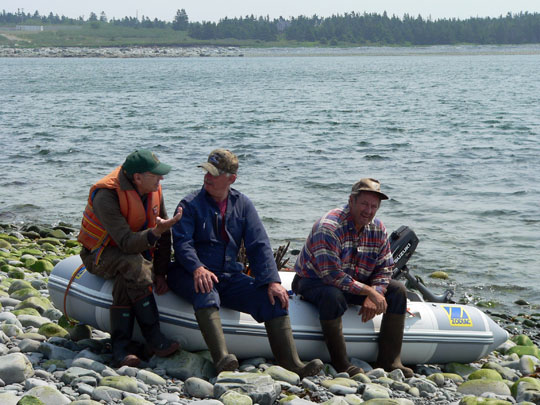 |
| Crew: Israel d'Entremont, Rémi d'Entremont and Paul Tufts |
July 4, 2005 - North Brother - No Mink presence. Perhaps 20 dead Common and Arctic Tern chicks, believed to be mostly weather related. Collected one 2 or 3 day old, recently dead, Common Tern chick. Found one dead adult Common Tern which appeared to have been killed by an avian predator. On another negative note, two Common Tern chicks were killed in the Mink traps we set a week earlier. Only one of the two was reset.
The island tern colony was very active and essentially in great shape in spite of the chick kills.
The hybrid tern chick was located again. It still had some Roseate Tern characteristics however the white breast feathers did not show the pinkish wash of a normal Roseate Tern chick of the same age. The feathers on its upper parts were also of a lighter colour.
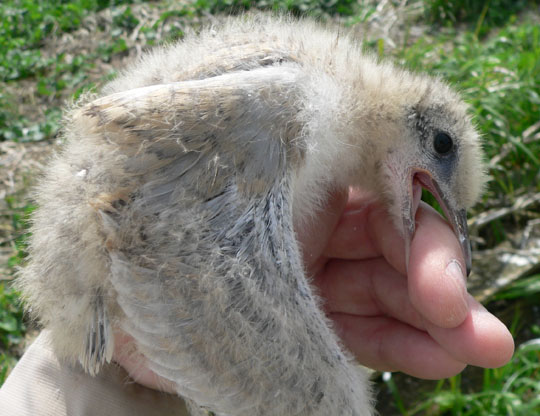 |
| Hybrid Roseate Tern chick - July 4, 2005 (Ted D'Eon photo) |
 |
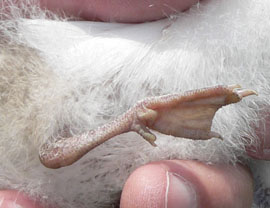 |
| Hybrid Roseate Tern | Its foot |
July 7, 2005 - North Brother - Quick visit. Still no Mink presence. Found one dead day-old Roseate Tern chick. Its 3 or 4 day old sibling in the nest box was fine. Another owl killed adult Arctic Tern with only a broken wing. I must note that for some reason, Arctic Terns, more than the other species, appear to be more vulnerable to owl predation. Perhaps the fact that they nest more in the open, on the bare beach rock area. There are perhaps 5 per cent Arctic Terns in the colony yet they are dispropotionately taken by the suspected avian predator. Just a thought.
Many of the previously occupied Roseate Tern nest boxes were empty. I assumed the chicks were in the vegetation as there were no carcasses (except for the one mentionned above).
In my haste, I forgot to check the Mink traps.
July 11, 2005 - North Brother - Another quick visit. No Mink presence. Another Common Tern chick in one of the Mink traps. The trap was not reset. Tern eggs still hatching. No new adult tern mortality.
Crew: Israel d'Entremont.
July 13, 2005 - Tern chick leg banding on N. Brother. Andrew Boyne of CWS arrived with Julie, Laura and Brad to band tern chicks on The Brothers. Nigel and I took them to N. Brother where 19 Roseate Tern chicks and a few Common Tern chicks were banded. Most of the chicks were over two weeks old; some were ready to attempt their first flight.
With the thick vegetation, we actually banded more ROST chicks than I expected we would be able to find. Most of the chicks were in the shelters where they had hatched or under neighbouring shelters.
One ROST chick, hiding in the vegetation, was accidentally stepped on and killed. A Common Crow was found dead in one of the Mink traps. 5 or 6 Common Tern chicks were also found dead. One COTE chick was found dead, stuck in the "Mink fence". There were still a few tern eggs in the process of hatching, however, the majority of the unhatched eggs appeared cold and likely would never hatch.
Three more unmarked Roseate Tern nests were found bringing the total ROST nest number to 68!
 |
| Julie and Andrew |
 |
| Roseate Tern chick being banded by Andrew Boyne |
July 20, 2005 - All was still well on N. Brother. I did a couple of hours of tern observation in the CWS portable blind. One banded adult ROST was seen. The characters on the band were not determined. The colony was very busy with adults carrying fish and feeding young. Lots of young terns in the air.
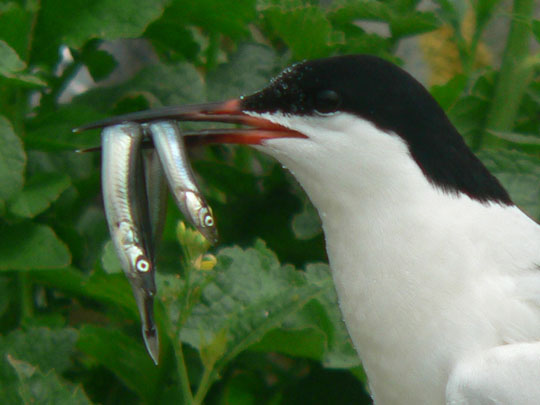 |
| Roseate Tern arriving with Sand Lance - July 20, 2005 (Ted D'Eon photo) |
 |
| Roseate Terns. Adult and chick - July 20, 2005 (Ted D'Eon photo) |
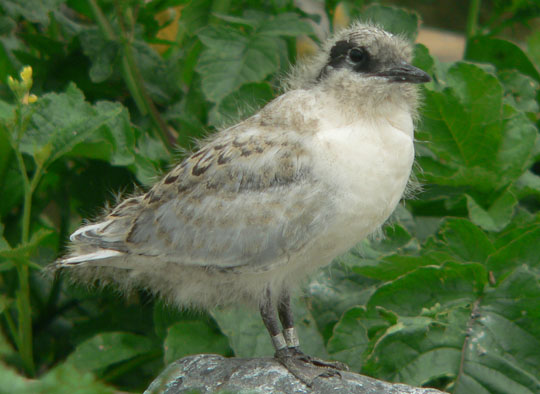 |
| Roseate Tern chick - July 20, 2005 (Ted D'Eon photo) |
July 22, 2005 - North Brother. All still very vibrant and exciting. Lots of adult terns carrying fish and feeding young. Many of the fledgeling young being fed at the edges of the island above the tide line. No recent tern mortality found. At least one un-banded Roseate Tern chick was seen. The colony was very healthy. Still many of the same unhatched and cold Roseate Tern eggs under the nesting shelters.
Crew: Liz, Linda and Reynolds.
 |
| Roseate Tern - N. Brother, July 22, 2005 (Ted D'Eon photo) |
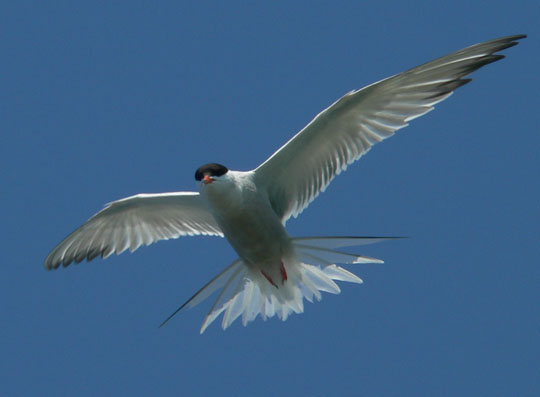 |
| Common Tern - N. Brother, July 22, 2005 (Ted D'Eon photo) |
 |
| Arctic Tern - N. Brother, July 22, 2005 (Ted D'Eon photo) |
July 30, 2005 - Stopped by N. Brother on our way to the "Mud Islands". We did not land on the island. Adult terns were still carrying food but the number of terns appeared down. I expect a lot of the terns had already left the island.
 |
| Common Puffin, Round Island, NS, July 30, 2005 (Ted D'Eon photo) |
August 7, 2005 - Removed the Mink traps from N. Brother. The terns had left the island.
Crew: Bernard Surette and his son, Gabriel.
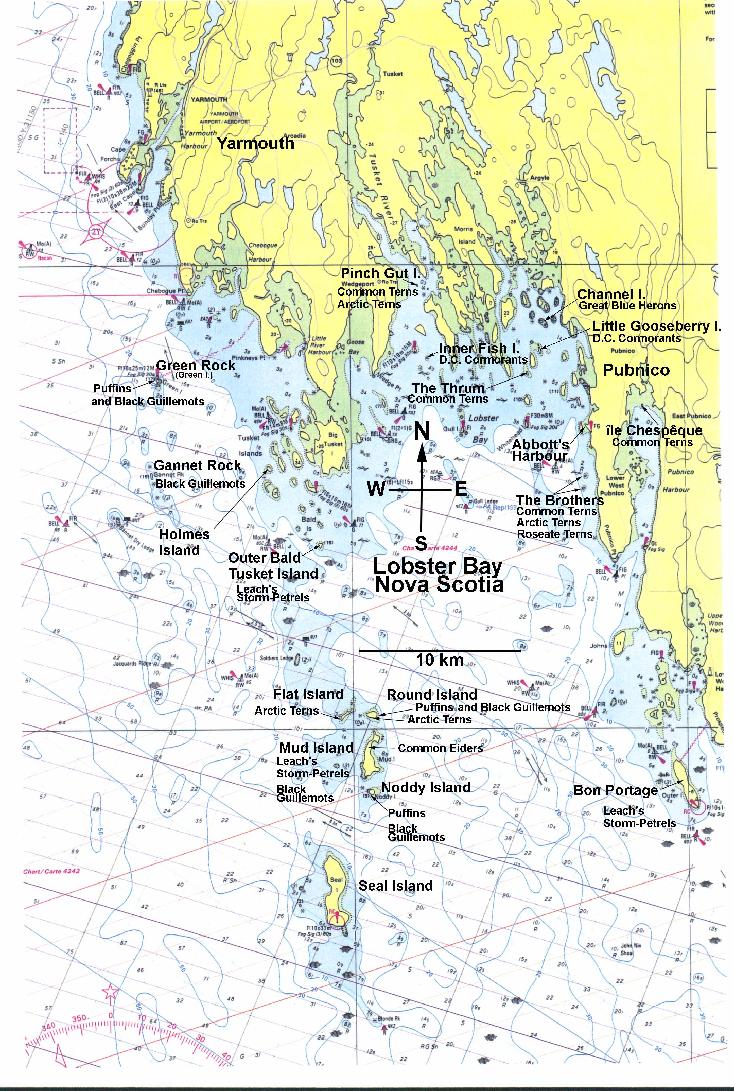 |